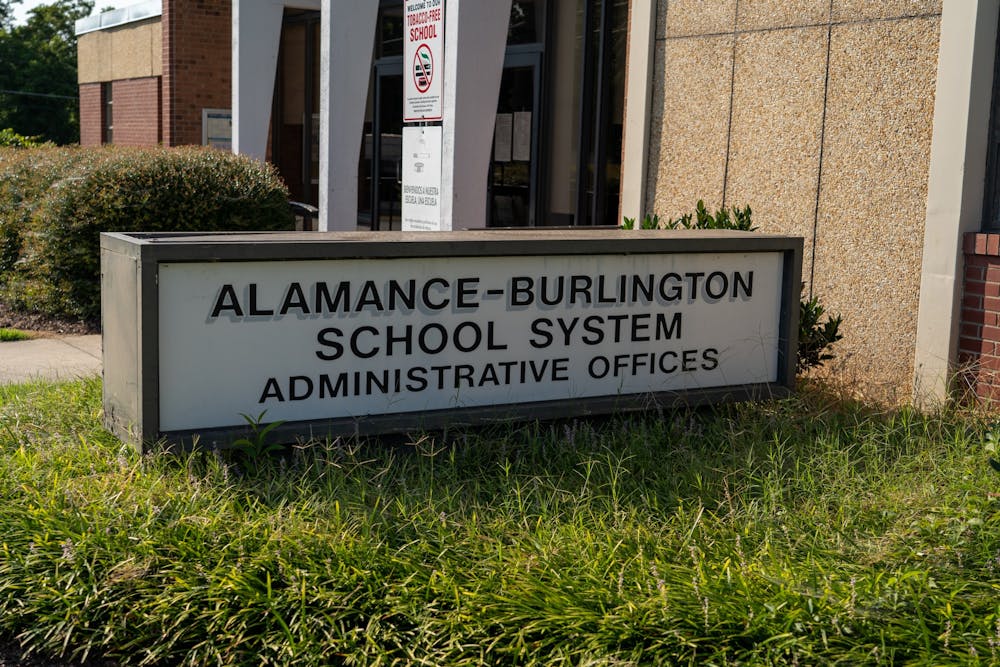The Alamance-Burlington School System covers the city of Burlington and surrounding areas in Alamance County. The district is set to release employee demographics for the 2020-2021 school year in October. While ABSS is working to increase diversity amongst its teachers, according to Public Information Officer Jenny Faulkner, the district has historically employed a vast majority of white teachers.
ABSS is one of North Carolina’s larger school districts, composed of 36 schools and 22,771 students as of 2019, according to the North Carolina Department of Public Instruction. The student body consists of about 65% white students and 35% students of color, according to data from the National Center for Education Statistics covering 2014 to 2018.
The proportion of total employees has historically hovered around three-quarters white, declining every two years from 80% in 2010 to about 74% in 2018, according to data reports by ABSS human resources.
The population of teachers in ABSS is no different. As of the 2019-2020 school year, ABSS reported about 80% white teachers and 20% teachers of color. Broken down, this amounts to 1,230 white teachers, compared to just 211 black teachers, the next most populous racial demographic in the district. The least populous demographic was American Indian, with just one teacher in ABSS.
The hiring process for the district begins online, according to Executive Director of ABSS Human Resources Dawn Madren. Prospective teachers can apply for positions through what she called the “NC School Jobs” website. From there, school administrators at each school will review the applications and select people for interviews.
Then, individual administrators can send in recommendations for new hires, and human resources will confirm that a background check and review for teaching license eligibility are both conducted. Individuals can then review their job offers.
ABSS is taking measures to recruit more teachers of color, according to Madren. These include attending more in-person and virtual college fairs, advertising job openings in the Alamance County relocation guide and hiring teachers through Participate Learning, an exchange program for international teachers.
Teachers hired through Participate Learning either work in the district’s dual language programs or fill existing vacancies, according to Madren. Teachers hired through the program “provide students with a variety of cultural experiences,” Faulkner wrote in a statement to Elon News Network.
“The relationships we form with Participate teachers have been especially powerful for our schools with a global language and cultural focus,” Faulkner said, “and they are helping us, in part, to fulfill our desire to increase diversity among our professional staff. We have more work to do in this area and continue to look for ways to increase our diversity.”
Faulkner acknowledged the disparity amongst ABSS teachers.
“Currently our workforce more closely aligns with the broader Alamance County population (per census data) than the children we serve,” Faulkner wrote in her statement, “so our goal is for our highly-qualified workforce to more closely mirror the faces we see in our classrooms.”
ABSS administration also recognizes the disparity, according to Faulkner, who said Superintendent Bruce Benson oversaw the creation of the Superintendent’s Equity, Diversity and Opportunity committee last year.
“Part of the committee’s work is to examine ways we can work to improve our progress toward achieving our equity and diversity goals across the district,” Madren wrote in a statement to Elon News Network. “This committee has been examining data like our professional teaching staff diversity in comparison with our students’ demographic diversity. We’ve made progress but we have more work to do.”
Benson wrote a letter to the community following the termination of a teacher for social media comments criticizing George Floyd protesters.
“We value diversity of both culture and thought as one of our community’s greatest strengths. It is our duty to work together to ensure that every voice is heard and valued,” he wrote.
Both Madren and Faulkner agreed that a national decrease in enrollment in teacher preparation programs has contributed to the lack of diversity in the district.
“As colleges graduate fewer teacher education candidates, ABSS and other districts in NC have had to rely on additional provisionally licensed candidates to fill teacher vacancies,” Madren said, adding that ABSS has “been intentional” with hiring candidates who are qualified for both a one-year provisional emergency license and a one-year provisional residency license in order to reduce turnover.
Citing the shortage of candidates, Faulkner said the district’s demographics are unlikely to see “dramatic shifts” when the new report is released in October.
“As recruiting highly-qualified educators continues to be more challenging, we expect that our efforts to improve the diversity of our teaching staff will continue to be slow and steady,” Faulkner said. “We don’t anticipate dramatic shifts to occur but our efforts to recruit and retain a diverse staff that reflects the faces in our classrooms remains our focus.”
The 2020-2021 demographic report will be released in early October. Faulkner said districts are required by the federal government to file reports in even-numbered years by Oct. 1, covering new hires from the beginning of July through the end of September. At the state level, a similar report must be filed each year. Faulkner said data for this year is not yet available as some positions are still being filled.


